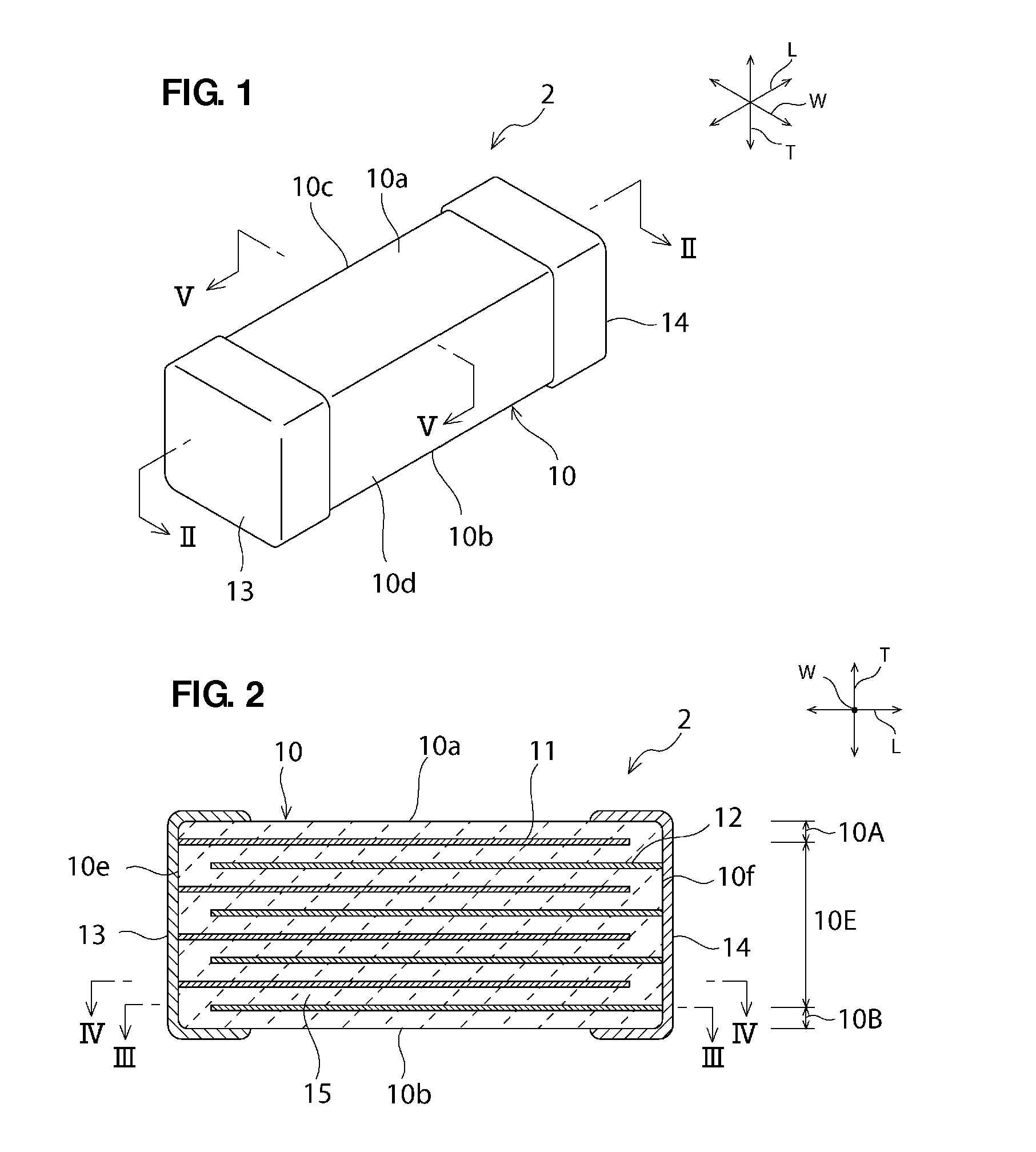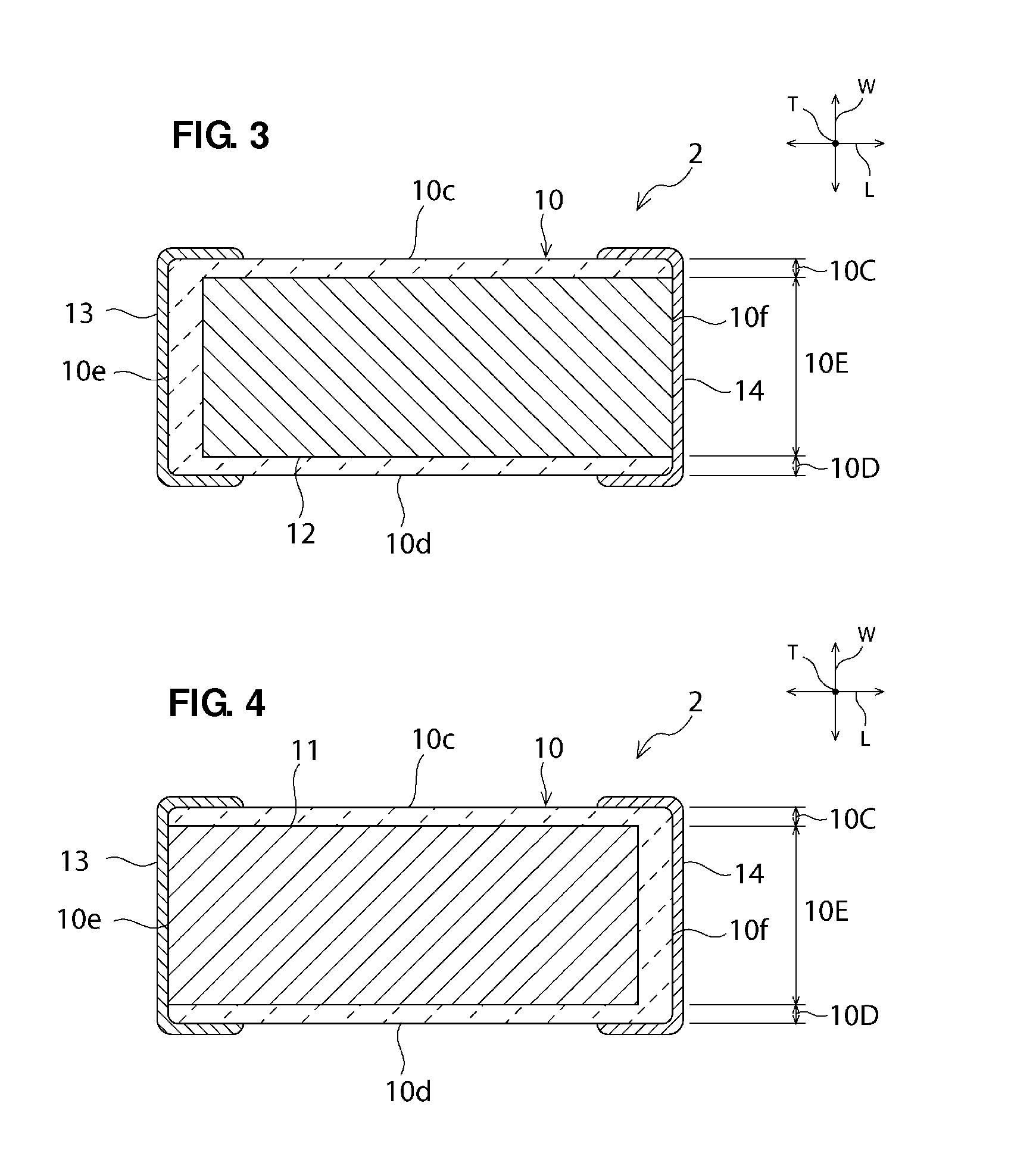Multilayer ceramic electronic component
a technology of electronic components and ceramics, applied in the direction of fixed capacitor details, stacked capacitors, fixed capacitors, etc., can solve the problems of time and effort required for the development of ceramic materials of high functionality, the capacity of multilayer ceramic capacitors has become larger and larger, and the development of ceramic materials with high functionality requires time and effort. , to achieve the effect of increasing electrical strength, greatly reducing electrical strength, and increasing electrical strength
- Summary
- Abstract
- Description
- Claims
- Application Information
AI Technical Summary
Benefits of technology
Problems solved by technology
Method used
Image
Examples
first preferred embodiment
[0044]FIG. 1 is a schematic perspective view of a ceramic electronic component according to a first preferred embodiment of the present invention. FIG. 2 is a cross-sectional view taken along the line II-II in FIG. 1. FIG. 3 is a schematic cross-sectional view taken along the line III-III in FIG. 2. FIG. 4 is a schematic cross-sectional view taken along the line IV-IV in FIG. 2. FIG. 5 is a partially enlarged cross-sectional view taken along the line V-V in FIG. 1. FIG. 6 is a schematic enlarged cross-sectional view of a portion VI in FIG. 5.
[0045]As illustrated in FIG. 1, a multilayer ceramic electronic component 2 according to the present preferred embodiment preferably includes a ceramic sintered body 10 having a substantially rectangular parallelepiped shape. The ceramic sintered body 10 includes first and second major surfaces 10a and 10b (first and second surfaces), first and second side surfaces 10c and 10d (third and fourth surfaces), and first and second end surfaces 10e an...
experimental example
[0071]The multilayer ceramic electronic component 2 according to the above-described preferred embodiment was produced and evaluated. As the multilayer ceramic electronic component, a multilayer ceramic capacitor was produced under the conditions described below.
[0072]Preferably, the dimension in the longitudinal direction is about 1.02 mm, the dimension in the width direction is about 0.53 mm, the dimension in the thickness direction is about 0.53 mm, the width of the side gap is about 0.05 mm, and the dimension of the end gap is about 0.09 mm, for example. The dimension of the end gap is the dimension between the tip of the internal electrode, that is, the tip of the first or second internal electrode 11 or 12 in the longitudinal direction L and the first or second end surface 10e or 10f to which that tip is not exposed. The thickness of the ceramic layer disposed between the first and second internal electrodes 11 and 12 is preferably about 1.1 μm and the thickness of an external...
embodiment
Modified Example of First Preferred Embodiment
[0088]FIG. 9 is a partially enlarged front view describing a modified example of the multilayer ceramic electronic component 2 according to the first preferred embodiment. In the present modified example, a saddle 11a is formed on the tip of each of the plurality of first internal electrodes 11. The saddle 11a occurs in an internal electrode edge portion at the time of forming an internal electrode by printing of conductive paste.
[0089]The saddle 11a is thicker than a remaining portion 11b of the first internal electrode 11.
[0090]Accordingly, if the saddles 11a overlap each other in the thickness direction, when a green stack is pressed in the thickness direction before firing, adhesion between the ceramic layers on both sides of each of the saddles 11a, that is, the ceramic green sheets may be decreased. The force exerted by the pressing on the portion in which the saddles 11a overlap each other and that on the portion in which no saddl...
PUM
| Property | Measurement | Unit |
|---|---|---|
| thickness | aaaaa | aaaaa |
| grain size | aaaaa | aaaaa |
| thickness | aaaaa | aaaaa |
Abstract
Description
Claims
Application Information
 Login to View More
Login to View More - R&D
- Intellectual Property
- Life Sciences
- Materials
- Tech Scout
- Unparalleled Data Quality
- Higher Quality Content
- 60% Fewer Hallucinations
Browse by: Latest US Patents, China's latest patents, Technical Efficacy Thesaurus, Application Domain, Technology Topic, Popular Technical Reports.
© 2025 PatSnap. All rights reserved.Legal|Privacy policy|Modern Slavery Act Transparency Statement|Sitemap|About US| Contact US: help@patsnap.com



